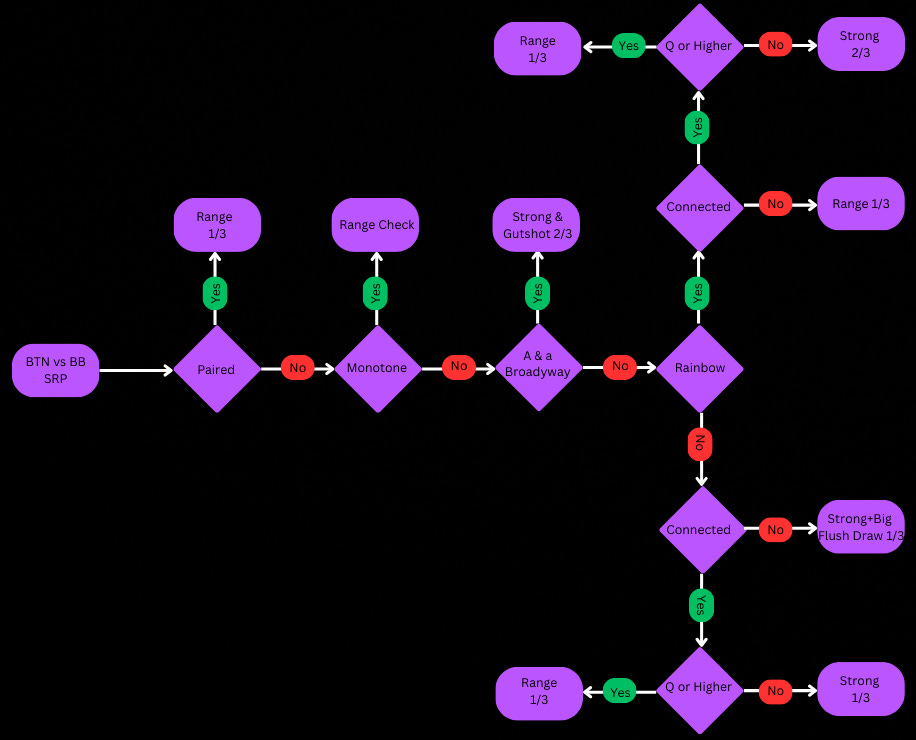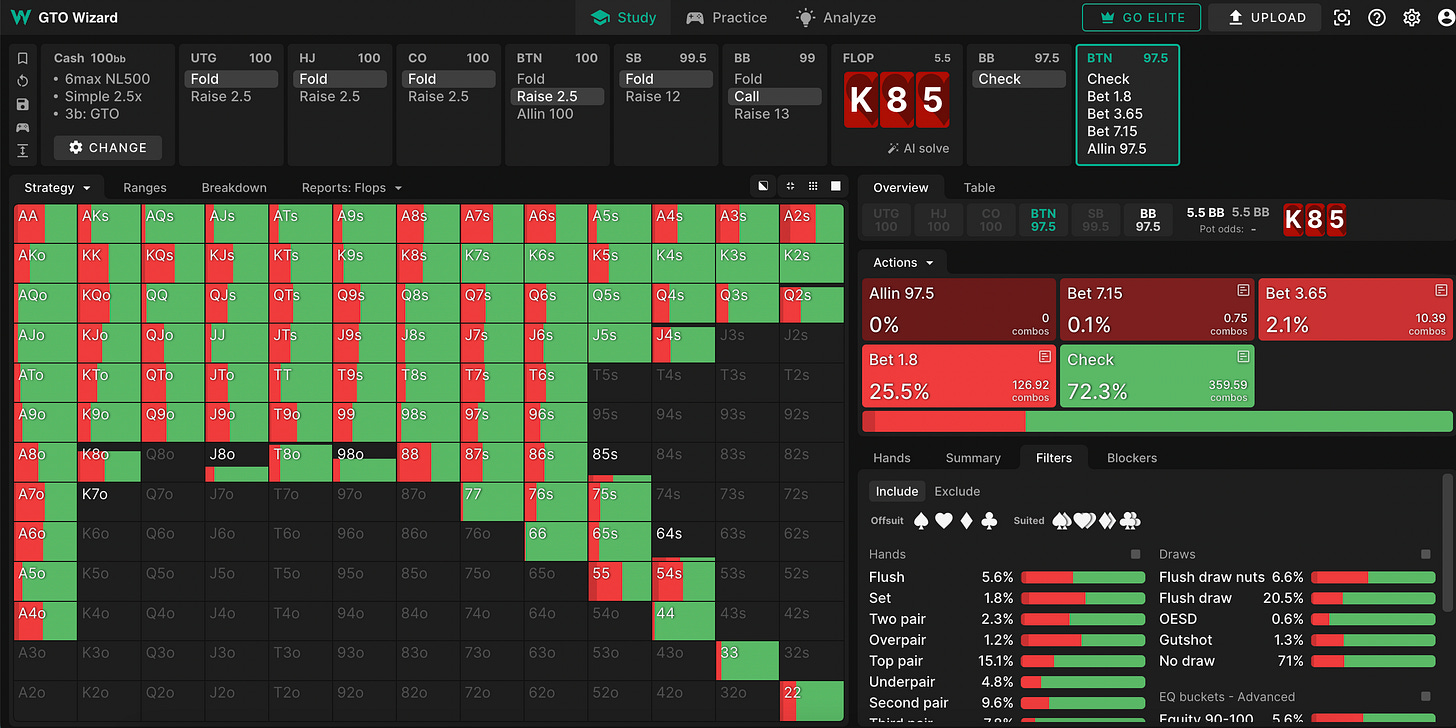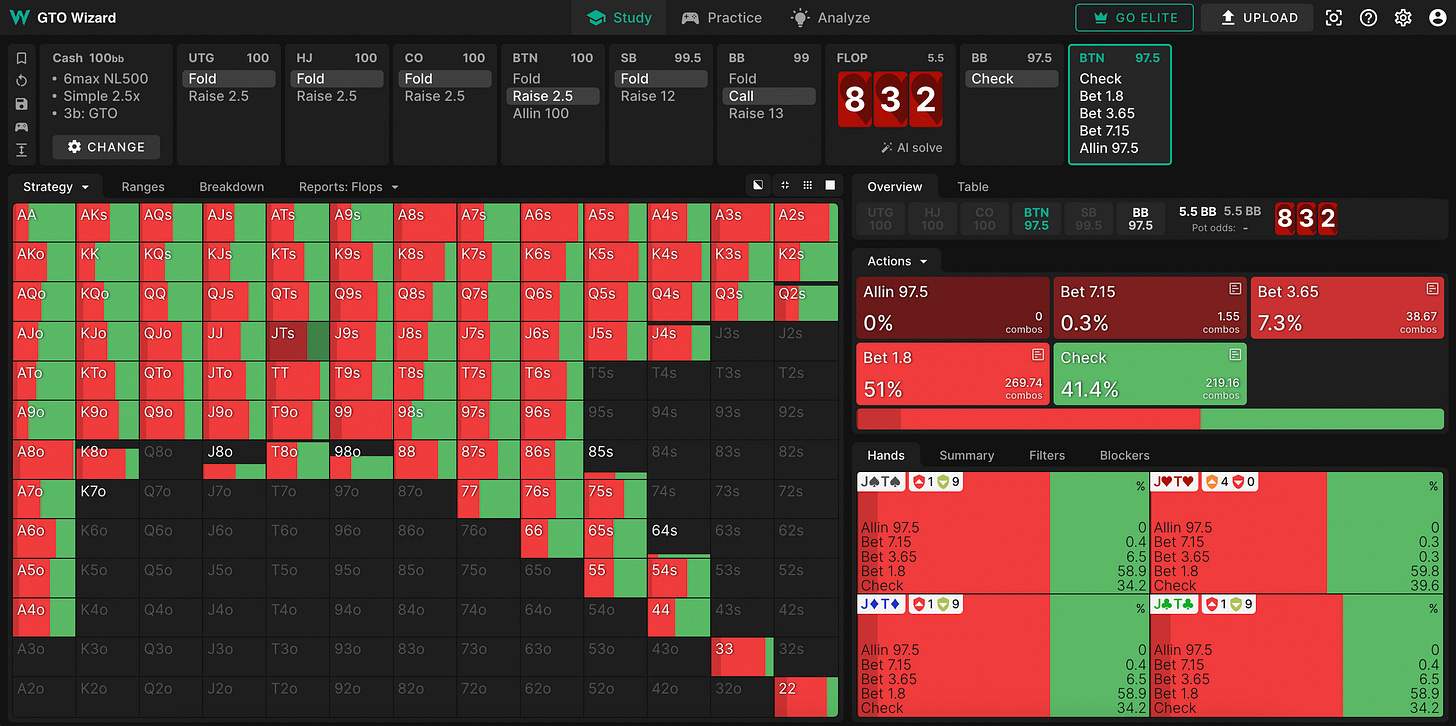Thanks to the magic of solvers, we now know what the game theory optimal line of play is in just about every spot you can encounter at a poker table. While it would be nice to memorize what actions to take at every spot in the game tree, this is about as possible as jumping to Mars or attending an 8am lecture (I’ve hear some people claim to have pulled it off but never quite believed them). So, in an effort to play better poker, I’ve analyzed over 1,000 flops to construct simple heuristics that help me evaluate particular spots. The following is my heuristic for a BTN vs BB single-raised pot. Below I’ll explain my methodology, get into the nuances of the position, highlight some edge cases, and explain my simplifications. But if you trust me and just want to know what to do when you open the button and the big blind calls, here it is1:
If the board is paired, bet range for 1/3 Pot. If the board is monotone check back range. If an A and another Broadway card comes bet your strong pair+ and gut shots for over 2/3. Otherwise, if the flop is disconnected and rainbow range bet 1/3 pot. If the flop is connected and rainbow your decision is dependent on the high card. If it's a queen or higher, bet your range for 1/3 pot. If it comes J or lower, bet strong made hands and half of your weakest hands for 2/3 pot. If the flop is disconnected two-tone, bet your strong made hands and your strong flush draws for 1/3 pot. If the flop comes connected two-tone, your decision once again depends on the high card. If it's Q or higher bet your range for 1/3 pot. If it's J or lower, bet your strong top pair+ for 1/3 pot.
While playing this approach perfectly will capture the large majority of the EV from the position, some of the simplifications made do forego some of it. If you’re able to execute a more complicated strategy, the following contains fewer simplifications therefore capturing more of the position’s EV. Though it is largely the same as the highly simplified version, it has a few important tweaks.
If the board is paired, bet range for 1/3 Pot. If the board is monotone check back range. If an A and another Broadway card comes get polar by betting your strong pair+ and gut shots for over bet sizing. Otherwise, if the flop is disconnected and rainbow range bet 1/3 pot. If the flop is connected and rainbow your decision is dependent on the high card. If it's a queen or higher, bet your range for 1/3 pot. If it comes J or lower, bet strong made hands and half of your weakest hands for 2/3 pot. If the flop is disconnected two-tone, bet your strong made hands and your strong flush draws for 1/3 pot. If the flop comes connected two-tone, your decision once again depends on the high card. If the high card is an A bet strong top pair plus for 1/3 pot. If the high card is a K or a Q, bet your strong hands always and then bet the rest of your range 50% of the time for 1/3 pot. If it comes J or lower, bet strong top pair+ for 1/3.
Methodology
Now that you’ve seen the strategies, it’s time to explain how I got there. I used the GTO Wizards flop reports tool to analyze the strategy of the button player on a sample of about 1100 flops, then filtered them to examine certain types of flops. For example, when developing the strategy for a monotone flop I filtered for monotone and then looked at the general strategy on the texture.
As you can see, a lot of checking is happening. The next thing I would do is randomly select 10-20 flops from the sub-sample and analyze each of them. While doing this I would make notes on what parts of the range were doing what for that particular flop. I found the equity buckets under the filters tool especially helpful.
I would then go over my notes for each flop in the sub-sample to identify patterns, and from there come up with the most coherent simplifications I could. For instance, I noticed that on monotone flops our flushes aren’t betting at much different frequencies as our suited hands that missed the flop. This, in part, is why I believe the strategy can be simplified to a range check.
Of course, there would always be some group of flops in the subset where the strategy would change or an individual flop that didn’t fall in line with the general pattern. While I would always make a note of this, if the strategy wasn’t radically different I would, if I thought appropriate, lump it into the simplification. For example, in the case of Montone, there are certain low disconnected flops where you want to be betting at a higher frequency. I determined that these cases were too rare and the change in strategy too insignificant to make a meaningful difference, so I believe one can simplify to range checking on monotone boards.
There were some subsets of flops I looked at where no clear symbolizations were possible, often due to the sheer number of flops in the subset. For example, flops that can be described as connected and two-tone make up a huge percentage of all the possible flops. In these cases, I began further filtering flops by high card and then started the process over with my new sub-sets. This worked rather well. All connected two-tone flops don’t have a clear common strategy, whereas all Ace high-connected two-tone one Broadway flops do.

Some Caveats
There were a few things I opted to simplify away in the spirit of the exercise, and while I don’t think these simplifications cost too much ev, I did want to share them here:
-Paired Boards: How high the cards are is correlated strongly with betting frequencies. The higher the cards, the more one should bet. The lower the cards, the less one should bet.
-Monotone: On some very low boards you want to increase your betting frequency.
-Connected Rainbow: On high boards while the simplification to bet range is solid, there are some checks in the position. They almost all come from underpairs.
-Connected Two Tone: On low boards betting all strong hands for 1/3 isn’t even really a simplification. It almost perfectly encapsulates the strategy.
-Overall: On extremely wet boards, betting frequencies tend to go down across all hand types.
-Overall: Very often the solver likes to mix in big bet sizing at small frequencies. However, I think forgoing this sacrifices a tiny amount of EV.
I’d love to hear people’s thoughts about the strategy, the simplifications, my method for developing them, or the position in general. One thing I can say for sure is after putting the hours in I feel way more confident playing the spot. Thanks for reading, the regular weekly update will be up on Monday.
Strong is defined as top pair strong kicker and better. Connected is defined as any flop where an open-ended straight draw is possible.








